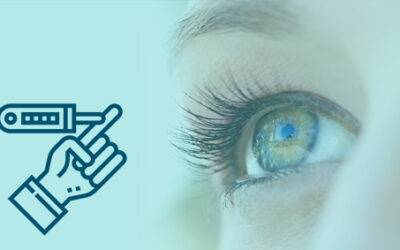Protecting Your Vision – Hemophilia and Eye Bleeds

While hemophilia is most commonly associated with joint bleeds, it is important to understand that bleeding can occur anywhere in the body, including the eyes. For individuals with hemophilia, the increased risk of bleeding poses unique challenges in managing their eye health. This blog article explores the potential eye complications in hemophilia, outlines preventative measures to safeguard your sight, and available treatment approaches.
Understanding Hemophilia and its Ocular Symptoms
- Recent injury to the eye or surrounding area
- Pain or discomfort around the eye
- Swelling in the eye area
- Changes in the colour of the eye (white-sclera, or coloured part- iris)
- Double or blurred vision
- Any other noticeable changes in vision
Effects of Hemophilia on the Eyes
W hile eye bleeding is not very common in hemophilia patients, it can occur and cause various negative effects, including:- Subconjunctival Hemorrhage – Individuals with hemophilia may experience spontaneous bleeding beneath the conjunctiva, the thin, transparent layer covering the white part of the eye. While often harmless, subconjunctival hemorrhages can cause redness and discomfort.
- Intraocular Hemorrhage – Hemophiliacs are at increased risk of bleeding within the eye, leading to conditions such as hyphema (bleeding into the anterior chamber of the eye), vitreous hemorrhage (bleeding into the vitreous humor), or retinal hemorrhage (bleeding into the retina). These hemorrhages require prompt medical attention as they can impair vision.
- Displaced Eyeball – In some uncommon cases, severe bleeding around the eye can push the eyeball forward, affecting its position. This may prevent the eyelid from closing completely, increasing the risk of infection.
- Vision Loss – Untreated significant bleeding behind the eye can, in serious cases, lead to permanent vision loss.
Remember, early intervention can significantly improve the chances of a full recovery and minimize vision loss.
Management and Treatment Of Eye Bleeds in Hemophilia
I f you experience any signs of an eye bleed, it is vital to seek immediate medical attention. Your hemophilia doctor will refer you to an ophthalmologist who will perform a comprehensive eye exam to determine the type and severity of the bleed and determine the best course of action. Here’s what to expect:- Factor Replacement Therapy – Depending on the severity, replacing the missing clotting factor in the blood through intravenous infusions can help stop the bleeding.
- Medications – In cases of subconjunctival hemorrhage or minor ocular bleeding, topical medications such as lubricating eye drops or ointments may be prescribed to alleviate discomfort and promote healing. Anti-inflammatory medications may be prescribed to reduce swelling and pain.
- Surgical Intervention – In severe cases of intraocular hemorrhage or retinal complications, surgical procedures such as vitrectomy or laser photocoagulation may be necessary to repair damage and preserve vision.
- Eye Rest – Depending on the bleed’s location and severity, your doctor may recommend rest and activity restrictions to promote healing.
Preventing Eye Complications in Hemophilia
- Regular Monitoring – Hemophiliacs should undergo regular eye examinations to monitor for signs of bleeding or complications. Early detection and intervention can help prevent progression to more serious eye conditions.
- Regular Hemophilia Treatment – Following your hemophilia treatment plan helps maintain adequate clotting factors and reduces bleeding risk.
- Protective Eyewear – Wearing protective eyewear during activities that carry a risk of eye injury, such as sports, contact sports, or using tools, is essential.
- Careful Contact Lens Use – Discuss contact lens wear with your ophthalmologist as they can increase the risk of infection, which could trigger bleeding.
- Avoid Strenuous Activities – High-impact activities or those with a high risk of falls should be approached with caution to minimize potential trauma to the eyes, as even a minor injury can result in severe bleeding.
- Addressing Other Eye Conditions – People with hemophilia are not exempt from developing other eye conditions like cataracts or age-related macular degeneration. However, some medications used to treat these conditions may require special considerations for those with bleeding disorders. It’s crucial to discuss all medications with your ophthalmologist and hemophilia treatment team to ensure a safe and effective treatment plan.
Your Eyesight, Our Focus – Working Together for Optimal Eye Health
Conclusion
Disclaimer – This content is for informational purposes only and should not be taken as medical advice. Always consult with your ophthalmologist regarding any eye concerns or treatment options.
Read More Eye Care Blogs
4 Eye Problems That Can Result from Diabetes
If you are a diabetic, it means that the blood glucose or blood sugar in your body is too high. Most of the food you eat is broken down by your body into glucose - the main source of energy that is used for the various functions of the body. Insulin (a hormone made by...
Eye Safety at Home – Tips to Prevent Eye Injuries
ur homes are meant to be safe havens, but they can also be unexpected sources of danger, especially when it comes to eye injuries. Whether it's a mundane task like cooking, working in the yard or garden, Do-it-yourself projects, or even playtime...
Safeguarding Young Eyes – A Comprehensive Guide to Preventing Eye Injuries in Children
s parents, guardians, and caregivers, safeguarding our children's well-being is always at the forefront of our minds. Yet, amidst all the protective measures we take, we may inadvertently overlook a crucial aspect of their health - their eyes. Eye...





